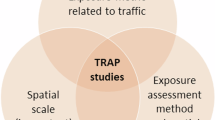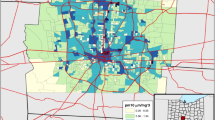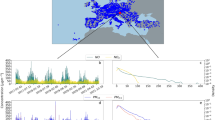Abstract
This study applies a traffic exhaust air dispersion model (the ExTra index) to 403 children enrolled in a French multicentric case–control study, the VESTA study (Five [V] Epidemiological Studies on Transport and Asthma). The ExTra index (previously validated by our team) was used to assess lifelong average traffic-related air pollutant (TAP) concentrations (nitrogen oxides) children in the study were exposed to in front of their living places. ExTra index took into account traffic density, topographical parameters (building height, road and pavement width), weather conditions (wind direction and strength) and background pollution levels. Topographical and traffic data were collected, using a specific questionnaire for each home, school or nursery address, attended by children. The assessment of time-weighted NOx levels in front of the children's living places highlighted significant disparities: mean ExTra index values and share attributable to proximity traffic were, respectively, 70±42 and 14±22 μg/m3 NOx equivalent NO2 for the 403 children in our study. Not only would this diversity not have been revealed using urban background pollution data provided by air quality networks, it would have resulted in 40% of the children being misclassified with regard to their TAP exposure by underestimating it in half of the cases and overestimating it in the other half. Such errors of classification, which are highly prejudicial in epidemiology, argue strongly for the use of an index such as the ExTra, which enables TAP exposure to be reconstructed within the framework of retrospective or prospective epidemiological studies.
This is a preview of subscription content, access via your institution
Access options
Subscribe to this journal
Receive 6 print issues and online access
$259.00 per year
only $43.17 per issue
Buy this article
- Purchase on SpringerLink
- Instant access to full article PDF
Prices may be subject to local taxes which are calculated during checkout


Similar content being viewed by others
References
Bartonova A., Clench-Aas J., Gram F., Gronskei K.E., Guerreiro C., Larssen S., Tonnesen D.A., and Walker S.E. Air pollution exposure monitoring and estimation. Part V. Traffic exposure in adults. J Environ Monit 1999: 1(4): 337–340.
Bellander T., Berglind N., Gustavsson P., Jonson T., Nyberg F., Pershagen G., and Järup L. Using geographic information systems to assess individual historical exposure to air pollution from traffic and house heating in Stockholm. Environ Health Persp 2001: 109(6): 633–639.
Benson P. A review of the development and application of the CALINE3 and CALINE4 models. Atmos Environ 1992: 26B(3): 379–390.
Berkowicz R., Hertel O., Sorensen N.N., and Michelsen J.A. Modelling air pollution from traffic in urban areas. In Proceedings of the IMA Conference on flow and dispersion through groups of obstacles, University of Cambridge, 28–30 March 1994, 1994.
Brauer M., Hoek G., van Vliet P., Meliefste K., Fischer P., Gehring U., Heinrich J., Cyrys J., Bellander T., Lewne M., and Brunekreef B. Estimating long-term average particulate air pollution concentrations: application of traffic indicators and geographic information systems. Epidemiology 2003: 14(2): 228–239.
Brauer M., Hoek G., van Vliet P., Meliefste K., Fischer P.H., Wijga A., Koopman L.P., Neijens H.J., Gerritsen J., Kerkhof M., Heinrich J., Bellander T., and Brunekreef B. Air pollution from traffic and the development of respiratory infections and asthmatic and allergic symptoms in children. Am J Resp Crit Care Med 2002: 166(8): 1092–1098.
Briggs D.J., de Hoogh C., Gulliver J., Wills J., Elliott P., Kingham S., and Smallbone K. A regression-based method for mapping traffic-related air pollution: application and testing in four contrasting urban environments. Sci Total Environ 2000: 253(1–3): 151–167.
Clench-Aas J., Bartonova A., Bohler T., Gronskei K.E., Sivertsen B., and Larssen S. Air pollution exposure monitoring and estimating. Part I. Integrated air quality monitoring system. J Environ Monit 1999a: 1(4): 313–319.
Clench-Aas J., Bartonova A., Gronskei K.E., and Walker S.E. Air pollution exposure monitoring and estimation. Part IV. Urban exposure in children. J Environ Monit 1999b: 1(4): 333–336.
Clench-Aas J., Bartonova A.K., Klaeboe R., and Kolbenstvedt M. Oslo traffic study—part 2: quantifying effects of traffic measures using individual exposure modeling. Atmos Environ 2000: 34: 4737–4744.
Coignard F. La caractérisation de l'exposition à la pollution atmosphérique dans les études épidémiologiques: comparaison de deux indices d'exposition au trafic, dans le cadre de l'étude VESTA. [pharmacy thesis], Université Claude Bernard, Lyon, Lyon 1, 1999.
Eerhens H.C., Sliggers C.J., and van den Hout K.D. The Dutch method to determine city air quality. Atmos Environ 1993: 27B: 389–399.
Gehring U., Cyrys J., Sedlmeir G., Brunekreef B., Bellander T., Fischer P., Bauer C.P., Reinhardt D., Wichmann H.E., and Heinrich J. Traffic-related air pollution and respiratory health during the first 2 yrs of life. Eur Resp J 2002: 19(4): 690–698.
Hertel O., and Berkowicz R., Modelling pollution from traffic in a street canyon. Evaluation of data and model development, DK-4000 Roskilde: National Environmental Research Institute; 1989 Report No.: DMU LUFT-A129.
Hoek G., Brunekreef B., Goldbohm S., Fischer P., and van den Brandt P.A. Association between mortality and indicators of traffic-related air pollution in the Netherlands: a cohort study. Lancet 2002: 360(9341): 1203–1209.
Hoek G., Fischer P., Van Den Brandt P., Goldbohm S., and Brunekreef B. Estimation of long-term average exposure to outdoor air pollution for a cohort study on mortality. J Expo Anal Environ Epidemiol 2001: 11(6): 459–469.
Huang Y.L., and Batterman S. Residence location as a measure of environmental exposure: a review of air pollution epidemiology studies. J Expo Anal Environ Epidemiol 2000: 10(1): 66–85.
Joumard R., and Lambert S. Evaluation des emissions de polluants par les transports routiers en France de 1970 à 2010. Rapport INRETS. Bron, France: INRETS; 1991 Report No.: no. 143.
Krochmal D., and Gorski L. Determination of nitrogen dioxide in ambient air by use of a passive sampling technique and triethanolamine as absorbent. Environ Sci Technol 1991: 25(3): 531–535.
Larssen S., Tonnesen D., Clench-Aas J., Aarnes M.J., and Arnesen K. A model for car exhaust exposure calculations to investigate health effects of air pollution. Sci Total Environ 1993: 134(1–3): 51–60.
Nyberg F., Gustavsson P., Jarup L., Bellander T., Berglind N., Jakobsson R., and Pershagen G. Urban air pollution and lung cancer in Stockholm. Epidemiology 2000: 11(5): 487–495.
Pershagen G., Rylander E., Norberg S., Eriksson M., and Nordvall S.L. Air pollution involving nitrogen dioxide exposure and wheezing bronchitis in children. Int J Epidemiol 1995: 24(6): 1147–1153.
Pikhart H., Bobak M., Kriz B., Danova J., Celko M.A., Prikazsky V., Pryl K., Briggs D., and Elliott P. Outdoor air concentrations of nitrogen dioxide and sulfur dioxide and prevalence of wheezing in school children. Epidemiology 2000: 11(2): 153–160.
Raaschou-Nielsen O., Hertel O., Thomsen B.L., and Olsen J.H. Air pollution from traffic at the residence of children with cancer. Am J Epidemiol 2001: 153(5): 433–443.
Raaschou-Nielsen O., Hertel O., Vignati E., Berkowicz R., Jensen S.S., Larsen V.B., Lohse C., and Olsen J.H. An air pollution model for use in epidemiological studies: evaluation with measured levels of nitrogen dioxide and benzene. J Expo Anal Environ Epidemiol 2000: 10(1): 4–14.
Reungoat P., Chiron M., Gauvin S., Le Moullec Y., and Momas I. Assessment of exposure to traffic pollution using the ExTra index: study of validation. Environ Res 2003: 93(1): 67–78.
Reungoat P., Chiron M., and Momas I. Assessment of exposure to traffic pollution in epidemiological studies: a review. Rev Epidemiol Sante Publique 2004: 52: 271–296.
Sacre C., Chiron M., and Flori J.P. Development of an exposure index of air pollution caused by motor vehicles for use in epidemiological studies. Sci Total Environ 1995: 169(1–3): 63–69.
Vignati E., Hertel O., Berkowicz R., and Raaschou-Nielsen O. Generation of input parameters for OSPM calculations, Sensitivity analysis of a method based on a questionnaire, National Environmental Research Institute, Denmark, 1997 Report No.: NERI Technical Report, No. 188.
Zmirou D., Gauvin S., Pin I., Momas I., Just J., Sahraoui F., Le Moullec Y., Bremont F., Cassadou S., Albertini M., Lauvergne N., Chiron M., Labbe A., and VESTA investigators. Five epidemiological studies on transport and asthma: objectives, design and descriptive results. J Expo Anal Environ Epidemiol 2002: 12(3): 186–196.
Acknowledgements
We are grateful to MM Pascale de Castelnau, Jean-Paul Flori, Nathalie Lauvergne, Yvon le Moullec, Isabelle Petit, Jérôme Pouey, Hervé Varale and Jérôme Vinet for their technical assistance. We also thank all the children and their families who volunteered for the demanding VESTA study, and the staff of the local air quality networks (AIRPARIF, ASCOPARG, ATMO-AUVERGNE, ORAMIP and QUALITAIR 06) for the environmental data that they gave us and for their advice. Patrice Reungoat benefits from a PhD grant funded by Agence de l'Environnement et de la Maîtrise de l'Energie (ADEME) and Institut National de Recherche sur les Transports et leur Sécurité (INRETS).
Author information
Authors and Affiliations
Corresponding author
Rights and permissions
About this article
Cite this article
Reungoat, P., Chiron, M., Gauvin, S. et al. Retrospective assessment of exposure to traffic air pollution using the ExTra index in the VESTA French epidemiological study. J Expo Sci Environ Epidemiol 15, 524–533 (2005). https://doi.org/10.1038/sj.jea.7500430
Received:
Accepted:
Published:
Issue date:
DOI: https://doi.org/10.1038/sj.jea.7500430
Keywords
This article is cited by
-
Land use regression modeling of intra-urban residential variability in multiple traffic-related air pollutants
Environmental Health (2008)



